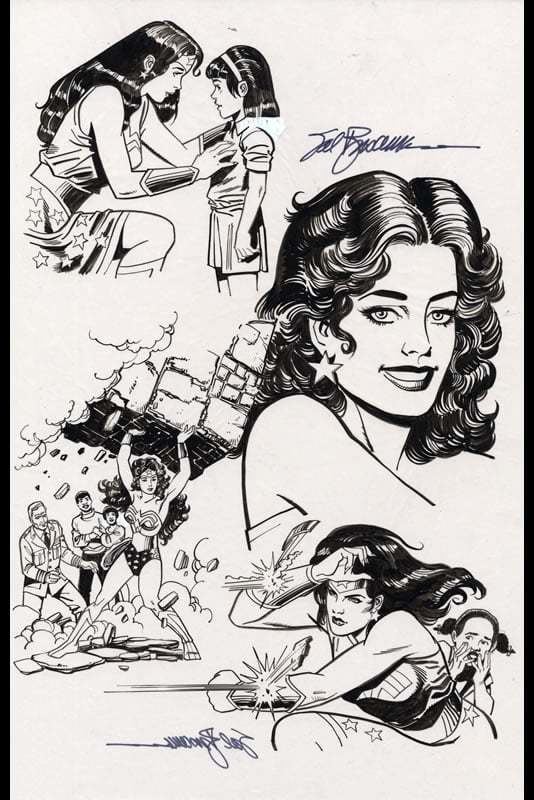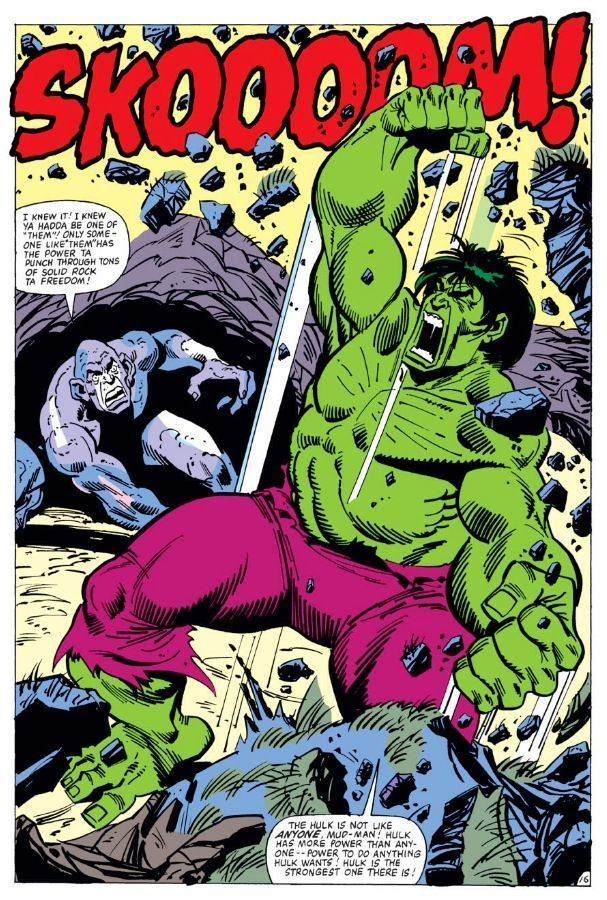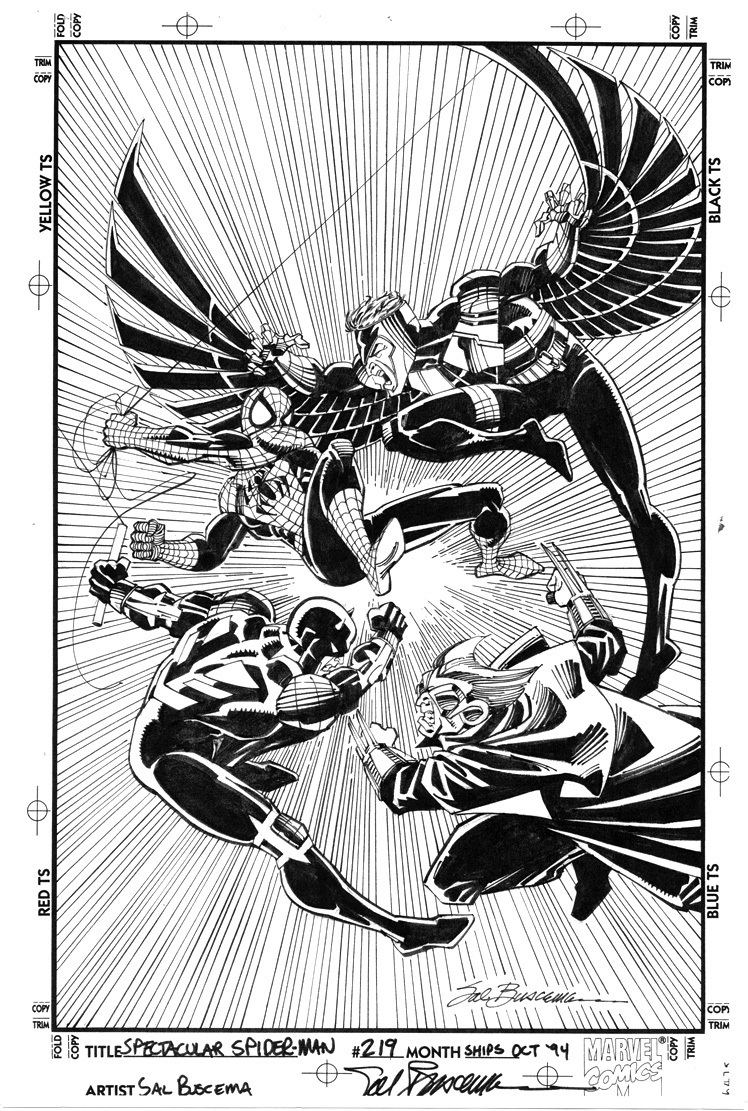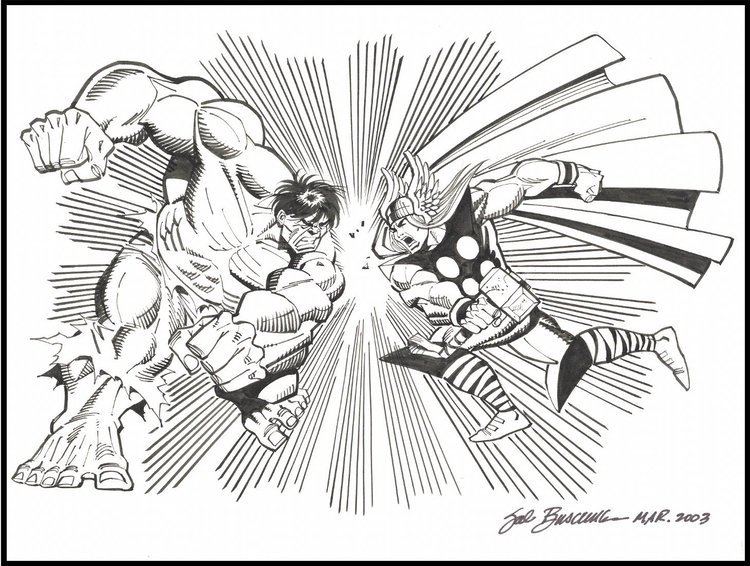Nationality American Siblings John Buscema | Name Sal Buscema Nieces Dianne Role Comic Book Creator | |
 | ||
Notable works Captain AmericaDefendersThe Incredible HulkMarvel Team-UpThe Spectacular Spider-Man Awards Hero Initiative Lifetime Achievement Award 2013Inkwell Award for The "SPAMI" Award (2013) Education Fiorello H. LaGuardia High School Books Avengers: Kree/Skrull War, Iron Man Omnibus Similar People | ||
Reviewing Silver-Age Avengers Collection Pt 3 Roy Thomas Sal Buscema Gene Colan @ JC'S Comics N More
Silvio Buscema (; born January 26, 1936) is an American comics artist, primarily for Marvel Comics, where he enjoyed a ten-year run as artist of The Incredible Hulk. He is the younger brother of comics artist John Buscema.
Contents
- Reviewing Silver Age Avengers Collection Pt 3 Roy Thomas Sal Buscema Gene Colan JCS Comics N More
- Herb trimpe guy dorian send message to sal buscema
- Early life and career
- Marvel Comics
- Later career
- Personal life
- Awards
- References

Herb trimpe guy dorian send message to sal buscema
Early life and career

Sal Buscema was the youngest of four siblings, his elder brothers Alfred (July 28, 1923-September 5, 2001) and John (1927–2002; a celebrated comic-book artist) and his sister Carol (June 22, 1929-April 14, 2004), are all deceased. Their father, who was born in Italy and died in 1973, was a barber.

Buscema grew up a fan of Hal Foster's Prince Valiant comic strip, of George Tuska's comic-book art, and of commercial illustrators such has Robert Fawcett, Al Parker, and Norman Rockwell, and called his artist brother John "greatly responsible for me pursuing drawing. ... John was definitely an inspiration".

Like John, Buscema attended the High School of Music & Art, graduating in 1955. He got his start as a comic-book inker in the early 1950s when his brother agreed to let him ink comics pages; this led to Sal helping John by doing occasional background art on Dell Comics series John was drawing.

After high school, Buscema found work at "a small, two-man advertising art studio in Manhattan" but was fired after three months of doing mostly production work. He went on to a larger commercial-art studio, where he was a gofer and a delivery person. He quit, then spent less than a year filling wedding-ring orders for the jewelry manufacturer J.R. Wood and Sons before being drafted into the peacetime U. S. Army in 1956. Classified as an "illustrator", he served with the Army Corps of Engineers stationed at Fort Belvoir in Virginia. He spent 21 months doing film strips and charts as training aids before being discharged after two years. He attained the rank of specialist 3rd class, which he called "equivalent to corporal."
After briefly returning to New York City to assist at a one-man art studio, an Army connection found him work at the large Creative Arts Studio in Washington, D.C. There he did illustrations for government agencies, including the Department of Agriculture and the Department of Defense. After living with his godparents for three months, Buscema and an Army buddy became roommates in Alexandria, Virginia. He started dating Joan, a secretary where he worked, in February 1959, and the two were married in May 1960. Their first son, Joe, was born in 1968, followed by Tony and Mike.
In 1961, a call from his brother John brought Buscema to New York City to work with him at the advertising agency Alexander Chaite, Inc. After a year-and-a-half, John Buscema returned to the comic-book industry while Sal Buscema joined a friend and colleague from Creative Arts Studio, Mel Emde, who was opening his own company, Design Studio. There Buscema stayed until 1968, when he began working for Marvel Comics, for which his brother was already established as a freelance artist.
Marvel Comics
Buscema by this time had spent "every night for about a year" teaching himself "how to produce a dynamic page" in the Marvel Comics storytelling style, enduring harsh critiques from his Marvel-artist brother John. As Buscema recalled in the late 2000s:
Once I got the hang of it I made up ... six sample pages of pencils [i.e. penciled, uninked art pages], which I regret, because I wanted to be an inker. I didn't want to pencil. My first few jobs for Marvel were inking jobs, but I did those while working for Design Center. I wanted to work full-time for Marvel, so it was out of necessity that I penciled. [Editor-in-chief Stan Lee] loved [the samples]. He asked me to come on up to New York, which I did, and I went through the most fantastic interview of my life. Stan was leaping on his chair and his desk, just to relate to me physically what he wanted on a comic-book page. It was fascinating and it was charming all at the same time. He made the sound effects, the whole nine yards. ... He demonstrated every other way you could possibly demonstrate what he wanted on those pages—the dynamics and so on.
The interview had come about after Buscema, at his brother's urging, had first written to Marvel production manager Sol Brodsky to introduce himself and his work. Brodsky had no assignments for him at the time, and Buscema "called him a couple of times just to bug him a little bit and let him know that I was still alive, and eventually the first job came through" in June 1968. That job, from Brodsky, was a 10-page Western feature, "Gunhawk". "I think they just said, 'Sal, here's the plot, go to it,'" Buscema recalled in 2003. That story, "The Coming of Gunhawk", by writer Jerry Siegel and penciler Werner Roth, was eventually published in the omnibus title Western Gunfighters #1 (cover-dated Aug. 1970). Buscema's first published comics work had come before that: inking John Buscema's pencil art on four 39- to 40-page stories in the superhero comic The Silver Surfer #4–7 (Feb.-Aug. 1969); and inking Larry Lieber's pencils on the regular-sized, 20-page Western The Rawhide Kid #68 (Feb. 1969).
John Buscema specifically asked for his brother as inker on The Silver Surfer, at the time a high-profile project dear to writer-editor Lee, who gave the character an unprecedented for the time double-sized, 64-page (with ads and covers) solo series priced at 25 cents, more than twice the price of the standard 32-page, 12-cent comic. Sal Buscema recalled,
Joe Sinnott inked the first three Silver Surfer [issues]. John was not happy with the inking Joe was doing on that. Joe is ... one of the greatest [inkers] of all time. But he did not ink John well ... because Joe's style of inking was somewhat overpowering, and at the end it ... didn't look like John Buscema anymore. John did not like that, because he was knocking himself out on this character, because this was a very important project that Stan had come up with. ... John told [Stan], 'I don't want Joe inking my work. He's losing my penciling.' ... Stan was very reluctant, but he said, 'Okay, who do you want?' He said, 'I want my brother,' and that's how I got it. ...[H]e knew that I knew how to ink his work. He was a little spotty on my first issue, but after that he was absolutely delighted with what I did.
Within a year, Buscema was penciling the superhero-team comic The Avengers, and for the next thirty years, he was one of the most prolific artists at the company. He recalled in the late 2000s, "At first I was very slow. If I knocked out six or eight pages a week I was happy. Then I started getting a little bit better, and I could probably do a couple of pages a day. But once I hit that five-year transitional period, I was like a machine. I could grind the stuff out. ... Everything just fell into place, and all of a sudden I found it very easy to do."
Sal Buscema and writer Roy Thomas introduced the Squadron Sinister in The Avengers #69 (Oct. 1969) as a homage to the Justice League. The Thomas/Buscema team produced the last new story for The X-Men title before that series became all-reprints for several years and created the super-villain Llyra in Sub-Mariner #32 (Dec. 1970). Buscema drew an Avengers story plotted by novelist Harlan Ellison which featured the debut of Psyklop. Writer Steve Englehart and Buscema launched The Defenders as an ongoing series in August 1972 and introduced the Valkyrie to the team in issue #4 (Feb. 1973). In addition to The Defenders, Buscema worked with Englehart on Captain America, their 1972–1975 run on that title saw it become one of Marvel's top-sellers. The pair teamed on several issues of The Avengers as well and Engelhart has described Buscema as being one of his "all-time favorites" and "a perfect comic book storyteller." After Englehart's departure from The Defenders series, Buscema remained on the title and worked with writers Len Wein and Steve Gerber. Buscema and Gerber crafted a story which saw the Defenders meet the Guardians of the Galaxy and added Starhawk to the latter team's roster. In 2010, Comics Bulletin ranked Buscema's collaboration with Gerber on The Defenders first on its list of the "Top 10 1970s Marvels". In addition, Buscema's work with Englehart on Captain America and The Avengers was ranked fourth and eighth, respectively, on the same list.
An early creative pairing with writer Bill Mantlo in Marvel Team-Up #48 (Aug. 1976) saw the first appearance of the Jean DeWolff supporting character. Mantlo, a frequent collaborator, later said that Buscema was a formative influence on his plotting. Buscema was the original artist on The Spectacular Spider-Man which debuted in December 1976. He and Jim Shooter created Graviton in The Avengers #158 (April 1977). The Rom series was launched by Mantlo and Buscema in December 1979. The Mantlo/Buscema collaboration on The Incredible Hulk included the creation of the U-Foes and the Soviet Super-Soldiers. Buscema had a 10-year run on that Hulk series, which he described as "[p]robably one of the most enjoyable experiences of my career. The fact that the Hulk is my all-time favorite character might be a contributing factor. I never tired of the character. Every story was a new challenge." He became the artist on New Mutants, beginning with issue #4 (June 1983). Buscema usually inked his own work, starting in the late 1970s. In 1986, he began drawing Thor working with Walt Simonson. In the late 1980s, he returned to inking others' work, again notably over his brother John Buscema's work on an Englehart-scripted run on Fantastic Four. His ability to meet quick deadlines and produce fast work has meant that in addition to his numerous regular titles, he has pencilled or inked many fill-in issues for Marvel.
Later career
From 1988 through 1996, he penciled and mostly inked a 100-issue run on The Spectacular Spider-Man. This included such story arcs as the "Lobo Brothers Gang War" with Gerry Conway and "The Child Within", written by J. M. DeMatteis, featuring the death of longtime Spider-Man supporting character Harry Osborn in #200 (May 1993). In a 2002 interview, DeMatteis said, "I really loved the two years on Spectacular Spider-Man that I wrote with Sal Buscema drawing. Talk about underrated! Sal is one of the best storytellers and a wonderful collaborator. I loved that run." Buscema worked for rival DC Comics, including penciling Batman, Superman, and Superboy stories, and inking the Creeper, Wonder Woman, and other characters' stories in 1997–1999. He recalled, "[T]he short time I worked for DC, they were giving me all these young guys that could hardly hold a pencil in their hands, and asking me to 'tweak it.' In cases like that I would definitely put a lot of myself into it and change whatever I felt needed to be changed."
Buscema returned to Marvel inking Pat Olliffe on Spider-Girl 1999, the summer annual of that series, and did work for both companies briefly before becoming the regular inker on The Incredible Hulk vol. 3, #11–20 (Feb.-Nov. 2000) and inking a smattering of other titles. In 2003 he described himself as "retired for three years ... and I'm still inking jobs for Marvel!" That same year he returned to comics full-time inking Oliffe on Spider-Girl #55 (March 2003) and then launching into a long stint inking or doing finished art over pencil layouts by Ron Frenz from issues #59–100 (June 2003 – Sept. 2006). He continued to ink the series when it was relaunched as The Amazing Spider-Girl #1–30 (Dec. 2006 – May 2009). He continued to ink Spider-Girl stories, over Frenz's pencils, in the omnibus title Web of Spider-Man vol. 2, #1–7 (Dec. 2009 – June 2010) and in the four-issue miniseries The Spectacular Spider-Girl vol. 2 (July–Oct. 2010) and the one-shot Spider-Girl: The End! #1 (Oct. 2010). In 2011, he was the inker, over Frenz, on the five-issue superhero miniseries Thunderstrike vol. 2. He returned to DC Comics in 2011 with DC Retroactive: The Flash – The '70s and a Superman one-shot, Superman Beyond In 2012, he inked IDW Publishing's G.I. Joe Annual and the ongoing Dungeons and Dragons: Forgotten Realms series.
Personal life
Buscema acts in community theatre. He was recognized for his portrayal of Tevye in Fiddler on the Roof, in which he appeared at the Little Theatre of Alexandria, Virginia in 1998.
Awards
Buscema received the Inkpot Award in 2003 and the Hero Initiative Lifetime Achievement Award in September 2013 at the Baltimore Comic-Con. In 2013, Buscema received the Inkwell Awards' S.P.A.M.I. Award (Favorite Small Press And Mainstream-Independent ’12 interior cover-dated American comic book ink work over another pencil artist (non-Marvel or DC work)) for his work on such titles as G.I. Joe Annual and Dungeons and Dragons: Forgotten Realms.
